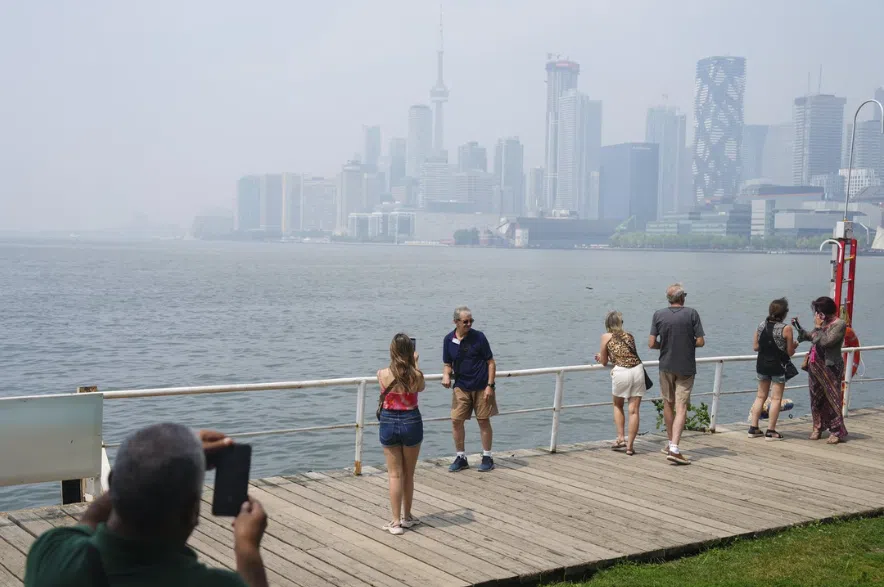Special air-quality statements caused by wildfire smoke remain in effect for many areas of the country, and in some places, people are also handling stifling heat and humidity as well as the haze.
Much of Central Canada, Manitoba and Saskatchewan were placed under special air quality statements or warnings on Monday due to smoke from wildfires on the Prairies and northern Ontario, as Environment Canada advised residents to limit time outdoors and watch for smoke exposure symptoms.
Read more:
- Wildfire now in Prince Albert National Park one of 55 burning in Saskatchewan
- Volunteer firefighters brave Muskeg Fire to save homes in Beauval
- Sask. wildfire smoke triggers air quality warning for Saskatoon
Air quality warnings for areas including Toronto were downgraded to special statements later on Monday as conditions somewhat improved, but a heat warning has been issued for the city that warns of daytime highs between 31 and 35 degrees lasting until Thursday.
Heat warnings are also in effect north of Lake Huron, as well as for parts of Newfoundland, Nova Scotia and New Brunswick.
Environment Canada says residents in areas with smoke warnings or advisories should consider limiting time outside and be mindful of smoke exposure symptoms.
And it says if there is an extreme heat event occurring with poor air quality, prioritize keeping cool.
Environment Canada suggests people check the Air Quality Health Index daily to determine how much time to spend outside. Here’s how to interpret the index:
How do I find out my local air quality reading?
Environment Canada’s air quality index can be found here.
You can take a look at the ratings in communities across your province or territory.
A rating of 1-3 is low risk, 4-6 is moderate risk, 7-10 is high risk and over 10 is very high risk.
The risk designations can change regularly in the same community, Environment Canada says, so it’s important to keep checking the air quality forecast.
What do the risk ratings mean?
Environment Canada, in consultation with Health Canada, has different recommendations for people especially at risk of suffering health problems when exposed to poor air quality compared to the general population.
“At risk” people include those with respiratory issues such as asthma, chronic obstructive pulmonary disease (COPD), pneumonia, as well those with as heart disease. Infants, young children, pregnant people and elderly people are also considered at higher risk.
The government agency lists the various health conditions that put you at higher risk at this website.
Here’s how to interpret the Air Quality Health Index guidance:
“Low risk” means everyone can safely be outdoors.
“Moderate risk” means the general population doesn’t need to change their usual outdoor activities unless they have symptoms such as coughing and throat irritation. But people at risk should “consider reducing or rescheduling strenuous activities outdoors.”
“High risk” means those at risk should reduce or reschedule strenuous activities outdoors. Children and seniors should “take it easy.” The general population should consider reducing or rescheduling strenuous activities if they start coughing or their throats become irritated.
“Very high risk” means everyone should reduce or reschedule strenuous activities. People at risk should avoid outdoor activities altogether











